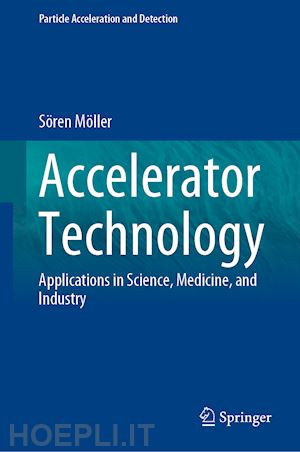
Questo prodotto usufruisce delle SPEDIZIONI GRATIS
selezionando l'opzione Corriere Veloce in fase di ordine.
Pagabile anche con Carta della cultura giovani e del merito, 18App Bonus Cultura e Carta del Docente
1.1. Vacuum
1.1.1. Pump technologies for the UHV range
1.1.2. Pumping systems and vacuum vessels1.2. Accelerators
1.2.1. DC1.2.2. AC
1.2.3. Laser
1.2.4. Electrons vs. ions
1.3. Ion and electron optics
1.3.1. Betatron function and emittance1.3.2. Optical elements
1.3.3. Magnetic field analysis
1.4. Ion sources
1.5. Detectors<
1.6. Targets
1.7. Radiation protection
1.7.1. Hazardous potentials for man and machine1.7.2. Avoidance strategies in plant conception
1.7.3. Shielding
1.7.4. Computer models
1.7.5. Legal framework
2. Interaction of particles and matter2.1. Absorption and reaction of photons
2.2. Stopping power and range of ions and electrons2.3. Nuclear reactions and activation
2.4. Depth-dependent reaction kinematics
2.5. Computer modeling
3. P
article generation with accelerators3.1. Reaction cross sections
3.2. Neutrons
3.2.1. The specific energy efficiency3.2.2. Neutron sources at accelerators
3.3. Photons3.3.1. X-ray sources
3.3.2. Synchrotron sources
3.3.3. Free-Electron Laser
3.3.4. Tscherenkov radiation
3.4. Particles of the standard model and antimatter4. Technical applications
4.1. Generation of a-ß-? emitters
4.1.1. Paths on the nuclide map
4.1.2. Comparison with thermal neutrons
4.1.3. Radiopharmaceuticals
4.1.4. Optimization of production efficiency
4.2. Radiotracers4.2.1. Radiotribologie
4.2.2. Traceable metastable isotopes4.3. Material modification
4.3.1. Doping by implantation and activation
4.3.2. Cleaning of new and waste products
4.3.3. Welding, cutting and additive manufacturing
4.3.4. Surface modifications4.3.5. Sterilization
4.4. Plasma applications4.4.1. Plasma Heating
4.4.2. Neutral beam injectors
4.4.3. Plasma accelerator
5. Nuclear Medicine
5.1. Radiation therapy5.1.1. X-ray irradiation
5.1.2. Proton therapy5.1.3. Neutron therapy
5.1.4. Radionuclide therapy
5.1.5. Selectivity from a physical perspective
5.2. Diagnostics
5.2.1. Information properties5.2.2. X-ray
5.2.3. Positron emission tomography
5.2.4. Single-photon emission computed tomography
6. Material testing
6.1. Ion, electron and photon beam analysis
6.1.1. Physical Concepts
6.1.2. Detection limit and accuracy6.1.3. X-ray absorption analysis
6.1.4. Elastic and inelastic particle scattering analysis6.1.5. Total Ion Beam Analysis
6.1.6. Mobile systems with radioactive sources
6.1.7. Focused-Ion Beam
6.1.8. Second
ary Ion Mass Spectroscopy 6.1.9. Electron microscopy6.1.10. Accelerator mass spectrometry
6.2. Neutron-based material analysis6.2.1. Neutron scattering
6.2.2. Imaging
6.2.3. Activation analysis
6.3. Radiation damage
6.4. Heat and particle loading tests7. Energy production and storage
7.1. Spallation7.2. Nuclear storage
7.3. Accelerator fusion
Sören Möller obtained his Diploma in Physics from the University of Bonn, Germany, in 2010 on the subject of nuclear fusion materials and solid-state physics. He continued studying nuclear materials for his PhD thesis with a strong focus on ion-beam analysis and physical chemistry. He obtained his PhD in 2014 at the University of Düsseldorf in cooperation with Forschungszentrum Jülich. In direct continuation, he took a postdoctoral position studying nuclear materials for fusion applications at Forschungszentrum Jülich. In 2014 he became a German state-appointed radiation protection officer, enabling him to install and patent his own end-station designs at a MeV scale tandem accelerator. Since 2017 he has been working as Senior Scientist for Ion-Beam Analysis in the Institute for Energy and Climate Research at Forschungszentrum Jülich mostly in the fields of material analysis for nuclear fusion and battery research.











Il sito utilizza cookie ed altri strumenti di tracciamento che raccolgono informazioni dal dispositivo dell’utente. Oltre ai cookie tecnici ed analitici aggregati, strettamente necessari per il funzionamento di questo sito web, previo consenso dell’utente possono essere installati cookie di profilazione e marketing e cookie dei social media. Cliccando su “Accetto tutti i cookie” saranno attivate tutte le categorie di cookie. Per accettare solo deterninate categorie di cookie, cliccare invece su “Impostazioni cookie”. Chiudendo il banner o continuando a navigare saranno installati solo cookie tecnici. Per maggiori dettagli, consultare la Cookie Policy.